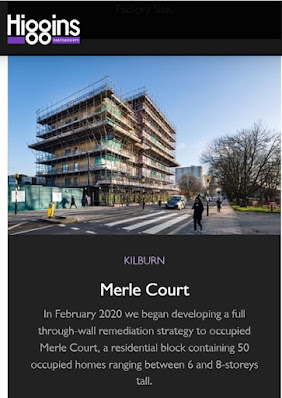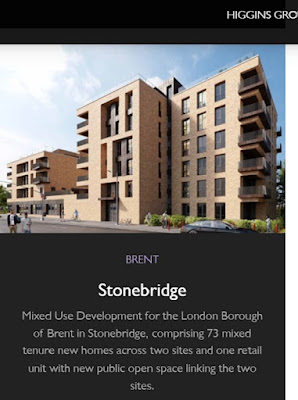Wembley Matters has been following the development of the Wembley Park 'regeneration' areas for some time. In October 2017 LINK I published the guest post below which attempted to look forward to the impact of what the author termed 'gentrification' rather than regeneration. Some might argue that 'gentrification' doesn't fit as very few residents lived in the largely light industrial and warehouse area that were displaced, but it could apply to the wider area with many working class people unable to continue to live here.
Since then we have seen what residents claim is over-development in Alperton, further demolition and building on South Kilburn estate with shrinking green space; masterplan for the Neasden Stations area with high rises on the College of North Wesr London Dudden Hill site and the light industrial area between Willesden High Road and Dudden Hill; and the huge re-development of the 'one public estate' (comprising Network Homes, NHS NW London, University of Westminster Brent Council) of what will almost be a new town in Northwick Park.
This is the original article with my introduction:
There
have been many postings on this website about Quintain's Wembley Park
'regeneration' and even more comments, particularly as the development has
accelerated recently eating up warehouse and industrial units and apparently
squeezing tower blocks into any spare space. In this guest posting Dilan
Tulsiani stands back and considers the implications for local people as well as
the locality itself.
On the 29th of August 2017, Quintain, a property investment and development business, announced via its website that it was ‘spending £1m a day on construction making Wembley Park one of the UK’s biggest construction sites’. According to Quintain, there will be over 8,500 jobs created, with a further 3,000 homes under construction ‘delivered at a pace not seen at any other London development site’. The construction framework consists of six contractors, the notables being: McLaren, Wates, Sisk and Carillion. Quintain have recently shifted their construction policy from ‘build to buy’ to ‘build to rent’. They aim to build over 7,000 new homes, with 5,000 labelled as ‘build to rent’, and a further 2,300 as “affordable”.
Quintain and Brent Council have both resisted using the term ‘gentrification’ to describe their partnership in transforming the area. Instead, you’ll see ‘regeneration’ on practically every website or poster promoting the ongoing process. This is understandable, as the critics of any form of gentrification, are quick to label the selective description by property developers as deceptive and dishonest. Technically speaking, regeneration is embedded within the process of gentrification. The Cambridge Dictionary defines regeneration: ‘to improve a place or system, especially by making it more active or successful’. Gentrification is defined as: ‘the process by which a place, especially part of a city, changes from a being poor to being a richer one, where people from a higher social class live’. Wembley Park’s ‘regeneration’ process factually falls under both definitions (for the remainder of this article I will use the term ‘gentrification’ instead of ‘regeneration’, as it is more accurate to my subject matter). Although, to prevent an ethical breakdown, new tenants would probably cling to ‘regeneration’ as an ontological justification for staying in Wembley.
Residents who have lived in Brent for more than a decade will remember the industrial abyss that used to exist just a short walk from the station. In this sense, the gleaming metallic towers, illusory designer outlet and newly placed pavement are well relished. However, there are a few fundamental concerns that have simply been swept aside. Firstly, the effect on the surrounding areas. There is no surprise, that most, if not all the flats in Wembley are not “affordable”. In fact, that term is usually used to provoke a narrative of relativity concerning financial status. Quintain has invested £900 million into Wembley Park, without careful consideration and evaluation from the residents of Brent, this could lead to some serious socio-economic disparities. David Fell, a research analyst at Hamptons International states that property prices in HA9 “have risen by 14% in the last year [2016], compared to a London average of 10%.” Just down the road from Wembley Park, a two-bedroom flat is valued around £335,000. A flat of the same size, less than 10 minutes’ walk away, is valued at £450,000 - £500,000. Recently, Alto has sold two-bedroom flats in Wembley Park for £800,000.
A similar problem was highlighted in 2014 during gentrification processes in South Kilburn, where a member of the Residents’ Association claimed: “Those who have been living in the area are essentially being driven out. This all amounts to a social cleansing of South Kilburn.” Moreover, Alpha, Gorefield and Canterbury Tenants’ and Residents’ Associations emphasised that the residents who have lived in South Kilburn for generations could no longer afford to live in their homes. These are not trivial or isolated matters. They’re simply the effects of gentrification. Wealth concentrated in one single area in this manner, will have drastic consequences. The surrounding populations will be allowed to use facilities, shops and walk the newly paved streets, but there is a cap on their indulgence of this ideology. Consider what the residents of Chalkhill think when their homes are (literally and metaphorically) overshadowed by the new apartment towers. When they, like so many other communities, have a lack of funding within their own neighbourhoods, along with other serious social issues. To name one, in Brent and Hounslow 34 high-rise buildings failed fire cladding tests issued after the horrendous disaster at Grenfell Tower. In contrast, I think it would be perfectly safe to assume that the newly built apartments in Wembley Park have some of the best fire safety systems available.
Attached to this disparity of wealth is the subsequent problem of crime. There is no doubt that the new properties will have a well-maintained police presence, due to the proximity of the stadium, along with security guards for each building. Due to the disparity, crimes in the surrounding areas may increase. Let’s take some of surrounding areas as examples (take these as approximate averages): From January - August 2017, Alperton has had the average total crime rate of 118/month, Dollis Hill’s average total crime rate was 137/month, and Tokyngton stands at an average of 188/month. Tokyngton is the closest of the three areas to Wembley Park, and in recent years it has had a subsequent increase in total crimes committed. If the investment in selective industries and areas remains or increases in the next decade, there should be no surprise at the increase in crime. This correlation was well represented in gentrification processes in New York, especially Harlem. As living standards get higher, the price of property increases, more people will forcibly turn to crime – both petty and serious. The socio-cultural divide will only widen.
One last fundamental issue is an assessment by The FA (for those like myself who are not sport literate: The Football Association). In May 2016, The FA complained that Brent Council was considering those who visit the stadium “an afterthought”. The recent constructions sites, which appear directly outside the stadium, could present potential hazards to fans, according to the FA. In fact, these new apartments would present the highest, and thus the most expensive flats, with their own personalised view of the games below them. Wembley is already set to be overcrowded, yet with ongoing construction, and busy venues/rush hour, there should be an effective policy by the council to counter this.
Ultimately, I see no realistic counter-movement to what seems to be an unchecked gentrification process at Wembley. In the next decade, Wembley, just as many other towns in Greater London, will be injected with huge sums of money, none of which will aid ingrained social issues, but will make these issues less noticeable for those living in the newly ‘regenerated’ areas. In the meanwhile, surrounding populations will attempt to readjust and comfort themselves from their high price of living with the luxurious shopping outlets built on the borders between their areas and the ‘newly regenerated Wembley Park’.
























